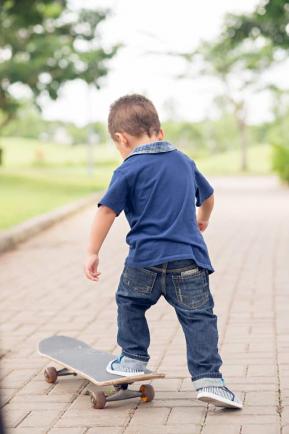
You saw it coming as you watched your energetic baby grow into an overactive toddler. You even nourished your child's sense of adventure as he explored the world around him. Curiosity is the key to learning, but what happens when your child isn't afraid of anything? Here are six tips for keeping your little daredevil safe.
Differentiate danger
Learn to discern the difference between what puts your child in actual danger and what simply makes you nervous. Address environmental issues you can control. If safety plugs in outlets aren't enough, move a piece of furniture. If running into the street is an issue, make the backyard the best playground. If your toddler won't stop climbing the bunk bed ladder while you are folding socks, throw the ladder up on the top bunk each morning.
Get out of the way
Let children fall. Let them resolve their own conflicts. Let them try what doesn't work so they learn what does. Let them take some risks when the danger is not too great so they can develop decision making and boundaries. Praise their tenacity and willingness to keep trying new things, hard things and scary things.
Cut parents (or yourself) some slack
Fearlessness in children can be a genetic predisposition. Therefore, if a child is reckless, it does not mean his parents are to blame. Instead of blaming parenting style, practice prosocial behaviors with your child and provide creative outlets for him to develop boundaries and empathy.
Channel the energy
Many accidents happen when kids have been alone too long or are bored and craving stimulation. Spending time playing with your kids in focused activities can help keep them busy and safe. Many parents love organized sports because they help teach teamwork and coordination while wearing children out in safer, more structured environments. Gymnastics is another excellent outlet for kids who will find a way to tumble anyway.
Protect without stifling
Fearless kids love to move and require a lot of playtime. Sometimes, simple changes can help create safety. One mom went running with her son, but her son often ran off the sidewalk. She started running around parks or soccer fields so her son had more room to roam while staying safe. One dad found smaller, individual trampolines for jumping and play when the roughhousing on the big one was out of control. Some grandparents had to have their trees trimmed so that the kids were not playing on unsafe branches.
Develop healthy pleasures
When children are focused on thrill-seeking, they sometimes lose their fears by conquering them. This pleasure response reinforces the child's behavior. Stressed children (e.g. children who often get into trouble or feel out of place), however, cannot always distinguish failure from success. These children might repeat negative behaviors in order to maintain familiar stress levels. This is often why punishing a fearless child never seems to work and why more positive and supportive parenting may be required. Helping a child find other things he can enjoy, feel good about and be praised for will help him reduce thrill-seeking behaviors.
Fearless kids struggle with impulse control, moral reasoning, boundaries, setting limits and sometimes even an ability to express love to others. Creating safe places in which your children can play will allow them the freedom to explore in developmentally appropriate ways while still nourishing their hunger to learn. Talk with your children about natural consequences as they experience them to improve their self-regulation. Playing with them will help them rehearse prosocial skills and develop empathy and understanding of how their choices impact those around them.

